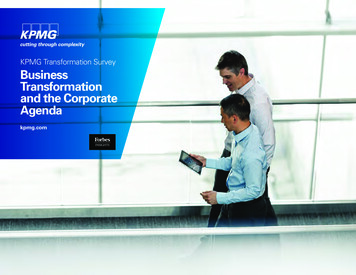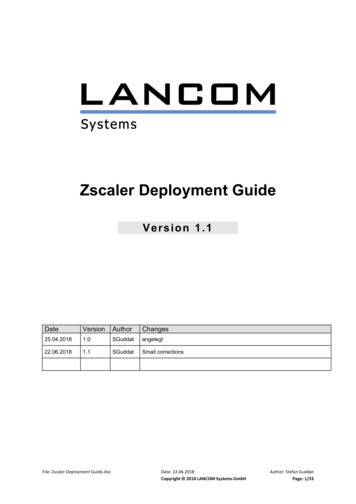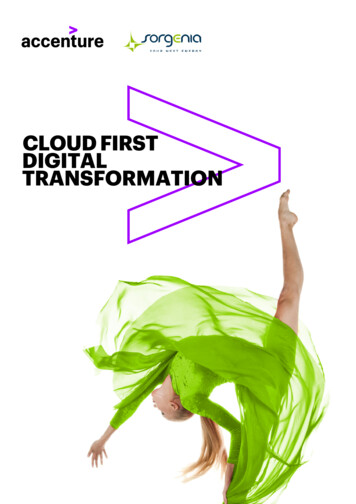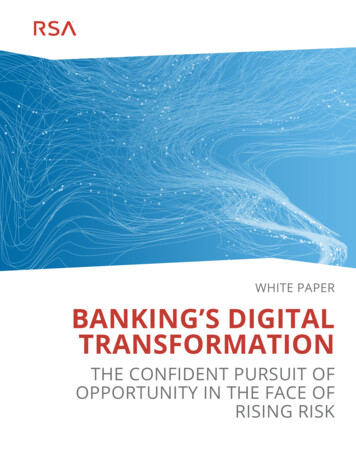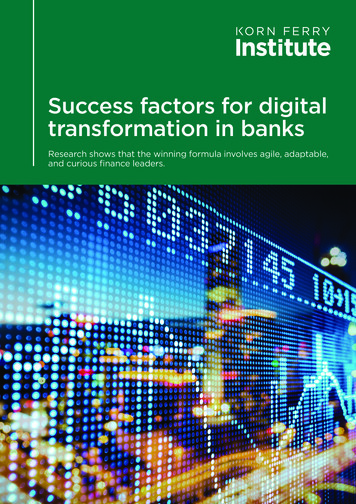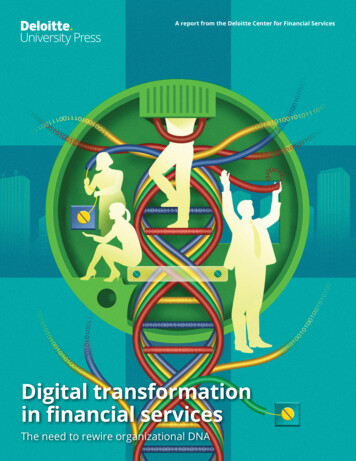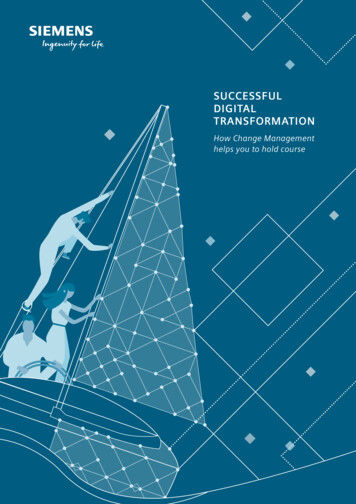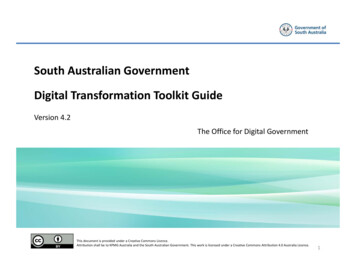
Transcription
Digital Strategy ToolkitDRAFTSouth Australian GovernmentDigital Transformation Toolkit GuideVersion 4.2The Office for Digital GovernmentThis document is provided under a Creative Commons Licence.Attribution shall be to KPMG Australia and the South Australian Government. This work is licensed under a Creative Commons Attribution 4.0 Australia Licence.1
Digital Strategy ToolkitAbout the toolkitThis Digital Strategy Toolkit currently comprises four tools foruse by South Australian Government departments, agenciesand authorities as they develop their digital strategies.1. Digital Maturity Assessment Tool2. Digital Transformation Prioritisation Tool3. Digital Strategy Template4. Digital Strategy Implementation Plan TemplateHow The Toolkit WorksThe Digital Strategy Toolkit provides South AustralianGovernment organisations with non-prescriptive guidance onthe development and format of their digital strategies. Thepurpose of the template and these notes is to make theprocess of developing a digital strategy more efficient andmake the output more effective for agencies.The Digital Maturity Assessment Tool and will help agenciesunderstand their current level of digital maturity and identifywhat they’re doing well and where improvements can bemade. The Digital Transformation Prioritisation tool will assistagencies to determine what digital projects they shouldundertake first. Both of these tools will help agencies to fill inthe Digital Strategy Template to articulate their digitaltransformation vision, how they plan to achieve it, and whatactivities they will be undertaking to gain the benefits ofdigital technology into the future. The implementation plantemplate can be used to map out these activities over thefollowing years.DRAFTWhat is a Digital Strategy?A digital strategy or plan is the articulation of anorganisation's vision, goals and purpose for engaging withdigital solutions and technologies. It articulates theopportunities and challenges related to digital activities,the governance and management arrangements and riskmanagement issues. It lays out a plan of action in order tomaximise the business benefits of digital initiatives to theorganisation.How Does a Digital Strategy Differ From an ICTStrategy?An Information and Communications Technology (ICT)strategy usually addresses the issues associated withidentifying, providing and maintaining the technologicalinfrastructure and solutions that enable an organisation tofulfil its vision and goals.Whereas an ICT strategy sets out the technicalinfrastructure (the pipes and plumbing) that underpins anorganisation’s use of digital solutions and channels, a digitalstrategy states what is to be channelled through the pipesand plumbing, how that is to be managed and why.The two strategies can be developed together. Thestrategies can be combined, or they can be kept separatewith references where appropriate to the other strategy.More detail on how digital is different is provided in theDigital Strategy Template section of this document.2
Digital Strategy ToolkitDefinitions and scopeCharacteristics of a digital strategyEffective digital strategies generally exhibitthese characteristics: Customers’ needs and expectations arethe over-riding consideration in decidingwhat services to provide, how and throughwhat channels. Empowers staff to think and act digitally, tobe innovative and to seek ways to transformbusiness processes and services to thedigital realm. Generates buy-in from staff andexecutives by explaining why digital isimportant, how important it is, and what thebenefits are. Articulates the aspirations andexpectations of the organisation for itsengagement with the digital world and ofputting the customer at the heart ofeverything it does.DRAFT Provides the ground rules andframework for imagining, creating,managing, delivering and monitoring digitalservices and digital channels. Identifies and addresses the factorscritical to the success of digital activitiesso as to minimise the risks and maximisethe benefits. Provides the criteria by which toprioritise digital activities so resourcesand energies are directed and plannedappropriately. Articulates and describes thecharacteristics of a digital culture so theorganisation can assess the nature andscope of the effort required to adopt andembed those characteristics. Reduces the risks of engaging with thedigital world and of failing to meet the needsand expectations of customers.3
Digital Strategy ToolkitDefinitions and scopeDRAFTStrategic AlignmentAn agency’s digital strategy shouldalign with: the Digital by Default Declarationand the across-government DigitalStrategy SA Connected the ten Economic Priorities insights from customerdata/research the agency’s mission, purpose,legislated responsibilities, andbusiness plan.4
Digital Strategy ToolkitDRAFTDigital Strategy templateBe aspirationalA digital strategy is about transforming services to make better use of digital technologies and solutions. This is more than just putting formsonline and enabling more online payments. It is not just about doing the same things we currently do more cheaply and faster. It is aboutbusiness model innovation that challenges the status quo – reimagining current functions and processes to transform services for citizens. Thinkabout how your digital strategy can lead your organisation from the traditional to the transformational end of the digital maturity spectrum.TraditionalTransitionalAnalogue radioDigital radioErratic quality of sound and the musicis selected by broadcaster. Talkbackradio is controlled by the station.Much better quality with morechannels and added features. Thebroadcaster is still in control. Talkbackradio is controlled by the station.TransformationalMusic streaming servicesDigital quality, anywhere, any device withpersonalisation and added features.The listener is in charge – they select,review, comment, and share.PandoraGovernment ServicesGovernment ServicesSpotifyGovernment Servicesdownload PDF formsonline formsfull digital maturityA government agency’s web pageprovides an application form as a PDFthat the user has to download,complete and post, drop in to a servicecentre or scan and email back.A government agency’s Web pageconverts the PDF application form to anonline form which is submitted online.Some of the agency’s transactions canbe paid via secure online payment.A government agency works with usersto understand their needs. It also workswith other agencies to join up services.As a result, it rethinks and remodels itsservice delivery. Processes are onlineand accessible to all users – mayinclude help blogs and feedbackfeatures.
Digital Strategy ToolkitDRAFTDigital Maturity Assessment Tool explainedThis Digital Maturity Assessment Tool enables organisationsto self-assess their level of digital maturity.The objective is to gain a picture of your organisation’scurrent level of digital maturity to help you identify whatyou’re doing well and where the improvements can be made.Understanding where you are on the digital journey has anumber of benefits including: Understanding strengths and weakness enablesmitigation strategies to be put in place It informs the prioritisation of resources and projects thatwill help accelerate advancing along the digital maturityjourney Understanding what full transformation looks likeprovides a goal to aim for.The tool presents five pillars of digital maturity (Governanceand leadership, People and Culture, Capacity and capability,Innovation, and Technology) and divides each pillar into 5levels of maturity - Minimal to Transformed. Under each levelis listed the characteristics we would expect to find in anorganisation that is at that level of digital maturity.Your maturity level rating: 2Why this rating? Most ticks appear in levels 1 and 2, andlooking at level 3 characteristics, the person from theorganisation doing the self-assessment felt the organisationwas clearly still at level 2.This tool is designed to be used by staff in an organisation ina position to know about its digital strategy, activities,channels and assets. For each pillar and for each level ofmaturity, staff tick any characteristic they feel theorganisation matches or exhibits. This results in a pattern ofticks which indicates the level of maturity – see the examplesto the right.Like most tools of this nature, it is not a scientific instrument.It is expected that those using it will exercise their judgementin determining the level rating of digital maturity for each ofthe pillars and the overall rating. The rating will be influencedby the reality that some organisations will give moresignificance to certain characteristics than others, and somewill know that they are close to meeting a certain aspect ofmaturity and will give a higher score in anticipation.Your maturity level rating: 3.5Why this rating? While most ticks appear in level 3,the one tick in level 4 was felt to be of significantweighting, and the staff training program is about to belaunched so the self-assessment was level 3.5.6
Digital Strategy ToolkitDRAFTDigital Maturity Assessment Tool – Governance and leadership1.The executive support, authorisation,and reporting processes and detailing ofroles and responsibilities.Read the characteristics of the 5 levels of digital maturity (Minimal to Transformed) and tick any of the characteristics ineach level you feel apply to your organisation.2.Look at the pattern of ticks you’ve given across Minimal to Transformed and then assess the digital maturity for thispillar and estimate a rating 1 – 5. e.g. if most of your ticks appear in levels Informal and reactive and Transitional, withhardly any in Customer-driven, your rating would be 3 – see the examples at the beginning of this tool. But use yourdiscretion, as some characteristics may have greater weighting than others for your organisation.Governance and leadershipGovernance and leadershipLevel 1MinimalLevel 2Informal and reactiveLevel 3TransitionalLevel 4Customer‐drivenLevel 5Transformed little buy-in from theexecutive for digitalsolutions or strategy a website exists but thereis no departmental digitalstrategy digital value propositionnot understood ordeveloped digital opportunities arenot understood or defined ad hoc digital projectsinitiated by internalgroups and individuals a social media presenceor engagement withcustomers has not beenpermitted by theexecutive value proposition of digitalstarting to beacknowledged byexecutive exploring the impact ofinnovation and emergingtechnologies on thebusiness some one-offcollaboration with otherdepartments regardingdigital service delivery social media channels aremonitored but socialmedia is seen more as arisk than an opportunity digital strategy in place roles and responsibilitiesfor delivering the digitalstrategy are clear andunderstood benefits are well-defined,understood strategic digitalpartnerships with otherdepartments focussed on audiencesand their needs andemerging technologies pro-active engagementwith customers across alldigital channels the benefits of socialmedia are understoodand drive social mediaactivity digital strategy integratedinto departmentalplanning process andinfluences overallorganisational strategyand direction benefits are well-defined,understood and drive alldigital activity KPIs and benefits to thebusiness and customersunderstood, monitoredand reported on seamless customerexperience across allchannels – digital andnon-digital strategic collaborationwith other departments,utilising multiple channels digital strategy isembedded in, andindistinguishable from,the organisational visionand strategy executive understandsand fully embraces digitalchannels and leads byexample new services andproducts are born digital non-digital services andproducts are reengineered, joined upand re-born as digital digital services andchannels drive theorganisational structureand reportingYour maturity level rating (tick the box): 1 1.5 2 2.5 3 3.5 4 4.5 5Some organisations have quite diverse service offerings and audiences.For them it may be appropriate to repeat this rating exercise for each distinct area of the organisation.7
Digital Strategy ToolkitDRAFTDigital Maturity Assessment Tool – People and culturePeople and culturePeople and cultureThe organisation’s culture, includingcustomer-focus, innovation, risk appetiteand attention to managing change –especially staff roles.1.Read the characteristics of the 5 levels of digital maturity (Minimal to Transformed) and tick any of the characteristics ineach level you feel apply to your organisation.2.Look at the pattern of ticks you’ve given across Minimal to Transformed and then assess the digital maturity for thispillar and estimate a rating 1 – 5. e.g. if most of your ticks appear in levels Informal and reactive and Transitional, withhardly any in Customer-driven, your rating would be 3 – see the examples at the beginning of this tool. But use yourdiscretion, as some characteristics may have greater weighting than others for your organisation.Level 1MinimalLevel 2Informal and reactiveLevel 3TransitionalLevel 4Customer‐drivenLevel 5Transformed bottom-up drive by stafffor embracing digitalculture little or no appetite in theorganisation for digitalservice delivery risk-averse and resistantto change limited or no attempt tounderstand customers fear of risk of engagementwith social media and ofstaff use of social media small number of staffengaged in digital projects some cross-organisationawareness of digitalopportunities risk-aversion inhibitingchange social media engagementrestricted to listening change managementstrategy developing starting to break downinternal silos andcollaborative practicesemerging digital strategy developedand embraced by staff digital team embedded inorganisational structure staff understand thebenefits and opportunitiesto them and customers ofthe digital st
the Digital Strategy Template to articulate their digital transformation vision, how they plan to achieve it, and what activities they will be undertaking to gain the benefits of digital technology into the future. The implementation plan template can be used to map out these activities over the following years. 2 What is a Digital Strategy?
